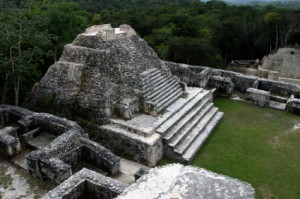 Article Preview By David Gobeil
Article Preview By David Gobeil
The Mayan civilization grew to be one of the most culturally and scientifically advanced peoples of their time period. Then, inexplicably over a fairly short period of time the Mayan civilization, in all greatness and advancements, totally disintegrated. There have been numerous theories on how the Mayan civilization seemed collapse so quickly, including disease, invasions from other peoples and famine due to extended droughts. Well, it appears the thesis about droughts leading to widespread famine has gained a lot more credibility after some researchers, including those from the University of New Mexico were able to accurately deconstruct and date mineral deposits on an ancient stalagmite found in a Belizean cave. The precise levels of rainfall over a period of time were ascertained through a process of radiogenic isotope dating and analysis at the University of New Mexico. The analysis clearly showed a period of decreased rainfall which coincides with archeological and historical dates that researchers say the Mayan civilization collapsed.
Read the article at its SOURCE:
The cover story in the journal “Science” this week features long-term research by an international group of anthropologists and earth and climate scientists, including researchers from the University of New Mexico, who took a careful look at the impact of climate change on Maya political systems. Their paper, “Development and Disintegration of Maya Political Systems in Response to Climate Change,” explores the effect of variations in rainfall.
To document the rainfall amounts, the group analyzed a stalagmite from Yok Balum cave in Belize. They precisely tracked an increase in rainfall between A.D. 450 and 600, then a decline in rainfall, punctuated by a series of short droughts 200 years later.
“This correlates with explosive growth and rapid expansion of Maya states across the lowlands, the proliferation of kings, and of carved monuments that talk about their successes,” said Keith Prufer, associate professor of Anthropology at UNM and one of the principal investigators. “Starting around the middle of the seventh century you see a decline in rainfall, corresponding with increasing incidents of warfare between competing states. There were a series of short droughts simultaneous with a collapse of polities in the southern lowlands of Belize and Guatemala. The northern part of the Maya culture in the Yucatan Peninsula continued to flourish well into the ninth century when a massive protracted drought beginning in the 11th century corresponds with a dramatic collapse at Chichen Itza and may have prevented the recovery of extant complex political systems.”
The precise chronological reconstruction of the climate record was conducted at the Radiogenic Isotope Laboratory at UNM Earth and Planetary Sciences, directed by Principal Investigator Yemane Asmerom along with Senior Research Scientist Victor Polyak and anthropology doctoral student Valorie Aquino. Some of the technical work was done by Aquino who drilled tiny trenches in the stalagmite and measured ratios of Uranium and Thorium isotopes from powders to accurately date the age of different layers linked to climate change.




